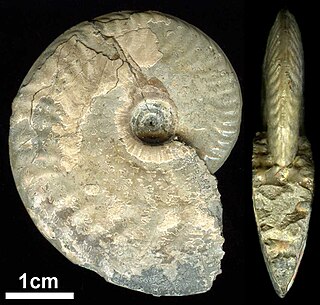Related Research Articles

Ammonitida or "True ammonites" are an order of ammonoid cephalopods that lived from the Jurassic through Paleocene time periods, commonly with intricate ammonitic sutures.
Abbasites is an extinct genus of ammonites from the early Middle Jurassic epoch, included in the ammonitid family Erycitidae.
Frechiella is an ammonite with a smooth, somewhat globose involute shell that lived during the later part of the Early Jurassic, which has been found in England and Italy. The shell is coiled so that the outer whorls cover most of the inner, leaving the inner whorls only slightly exposed. The outer rim, known as the venter, is broadly arched, with either a low narrow keel bordered by small grooves, or a large median groove.

Ammonitina comprises a diverse suborder of ammonite cephalopods that lived during the Jurassic and Cretaceous periods of the Mesozoic Era. They are excellent index fossils, and it is often possible to link the rock layer in which they are found to specific geological time periods.
Euaptetoceras is an evolute hildoceratoid ammonite from the lower Middle Jurassic, included in the family Hammatoceratidae and the subfamility Hammatoceratinae. The genus may be a junior synonym for Eudmetoceras of Buckman, 1920.
Haplopleuroceras is a Middle Jurassic ammonite and likely member of the Hildoceratacean family Sonniniidae with which it shares the same sort of ribbing.

Psiloceras is an extinct genus of ammonite. Psiloceras is among the earliest known Jurassic ammonites, and the appearance of the earliest Psiloceras species form the definition for the base of the Jurassic. Unlike most earlier ammonites, which had complex shell shapes and ornamentation, Psiloceras had a smooth shell.
Haploceratoidea, formerly Haplocerataceae, is an extinct superfamily of ammonoid cephalopods belonging to the Ammonitida that unites three families, Strigoceratidae, Oppeliidae, and Haploceratidae, listed below.

Stephanoceratoidea, formerly Stephanocerataceae, is a superfamily of middle- upper Jurassic ammonoid cephalopods within the order Ammonitida containing diverse forms, generally with sharp ribbing and complex suture lines. Aptychi are believed to be mostly granular (Granulaptycus) or concentrically ribbed on the surface (Praestriaptychus)
Otoidtidae: stephanoceratoid ammonitina from the early Middle Jurassic that begin as cadicones but become more planualte with age; derived from the Hammitoceratidae (Hildoceratoidea), probably through Erycites by way of Abbasites.

Hildoceratoidea, formerly Hildoceratacaea, is a superfamily of compressed or planulate ammonites, some tending to develop acute outer rims; generally with arcuate or sigmoidal ribs. Aptichus were found in place are double-valved.

Oppeliidae are compressed to oxyconic, sculptured Haploceratoidea, either unkeeled, unicarinate, bicarinate, or tricarinate; with sutures in great variety, but ribbing usually more or less falcoid or falcate. The Oppeliidae is the principal family of the Haploceratoidea, with the longest duration, extending from the Middle Jurassic (Bajocian) to the Upper Cretaceous (Cenomanian) Their derivation is from the Hildoceratoidea.

Hildoceratidae is a family of ammonoid cephalopods from the Lower Jurassic, lower Pliensbachian to lower Bajocian substages, generally with strongly ribbed, involute shells. They are combined with the Hammatoceratidae, Graphoceratidae, and Sonniniidae to make up the Hildoceratoidea.

Perisphinctidae is a family of Middle and Upper Jurassic discoidal ammonites in the order Ammonitida. They have a shell morphology that is mostly evolute, typically with biplicate, simple, or triplicate ribbing. Large forms have simple apertures and smooth body chambers while small forms have lappets and ribbed body chambers.

The family Dactylioceratidae comprises Early Jurassic ammonite genera with ribbed and commonly tuberculate shells that resembled later Middle Jurassic stephanoceratids and Upper Jurassic perisphinctids. Shells may be either evolute or involute.
Sonniniidae is a diverse family of Middle Jurassic ammonites ranging from those with stout evolute shells to those whose shells are sharply rimmed, oxyconic. The keel, which runs along the middle of the venter, is typically hollow. Sutures vary from simple to complex. The aptychus is shiny with coarse folds (Cornaptychus).
Erycitidae is a family of Lower and Middle Jurassic ammonites included in the Hildoceratoidea. The hammatoceratid subfamily Erycitinae is equivalent. Genera include Erycites (type) and Abbasites.

Hammatoceratidae is a family of lower and middle Jurassic ammonites included in the superfamily Hildoceratoidea.

Hammatoceras is a genus of ammonites belonging to the family Hammatoceratidae which lived during the Toarcian stage of the Early/Lower Jurassic between about 184 and 175 million year ago.
Bredyia is a genus of ammonites from the lower part of the Middle Jurassic, found in Europe and North America.
References
- ↑ Paleobiology Database Hammatoceratoidea entry
- ↑ Arkell, W.J.; Kummel, B.; Wright, C.W. (1957). Mesozoic Ammonoidea. Treatise on Invertebrate Paleontology, Part L, Mollusca 4. Lawrence, Kansas: Geological Society of America and University of Kansas Press.
- ↑ D.T. Donovan et al., 1981. Classification of Jurassic Ammonitina. The Ammonoidea. Systematics Association special volume 18.